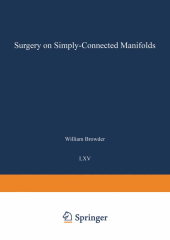 Neuerscheinungen 2012Stand: 2020-01-07 |
Schnellsuche
ISBN/Stichwort/Autor
|
Herderstraße 10
10625 Berlin
Tel.: 030 315 714 16
Fax 030 315 714 14
info@buchspektrum.de |

William Browder
Surgery on Simply-Connected Manifolds
Softcover reprint of the original 1st ed. 1972. 2012. x, 134 S. 1 SW-Abb. 229 mm
Verlag/Jahr: SPRINGER, BERLIN 2012
ISBN: 3-642-50022-6 (3642500226)
Neue ISBN: 978-3-642-50022-0 (9783642500220)
Preis und Lieferzeit: Bitte klicken
This book is an exposition of the technique of surgery on simply-connected smooth manifolds. Systematic study of differentiable manifolds using these ideas was begun by Milnor [45] and Wallace [68] and developed extensively in the last ten years. It is now possible to give a reasonably complete theory of simply-connected manifolds of dimension ~ 5 using this approach and that is what I will try to begin here. The emphasis has been placed on stating and proving the general results necessary to apply this method in various contexts. In Chapter II, these results are stated, and then applications are given to characterizing the homotopy type of differentiable manifolds and classifying manifolds within a given homotopy type. This theory was first extensively developed in Kervaire and Milnor [34] in the case of homotopy spheres, globalized by S. P. Novikov [49] and the author [6] for closed 1-connected manifolds, and extended to the bounded case by Wall [65] and Golo [23]. The thesis of Sullivan [62] reformed the theory in an elegant way in terms of classifying spaces.
I. Poincaré Duality.-
1. Slant Operations, Cup and Cap Products.-
2. Poincaré Duality.-
3. Poincaré Pairs and Triads; Sums of Poincaré Pairs and Maps.-
4. The Spivak Normal Fibre Space.- II. The Main Results of Surgery.-
1. The Main Technical Results.-
2. Transversality and Normal Cobordism.-
3. Homotopy Types of Smooth Manifolds and Classification.-
4. Reinterpretation Using the Spivak Normal Fibre Space.- III. The Invariant ?.-
1. Quadratic Forms over ? and ?2.-
2. The Invariant I(f), (index).-
3. Normal Maps, Wu Classes, and the Definition of ? for m = 4l.-
4. The Invariant c(f, b) (Kervaire invariant).-
5. Product Formulas.- IV. Surgery and the Fundamental Theorem.-
1. Elementary Surgery and the Group SO(n).-
2. The Fundamental Theorem: Preliminaries.-
3. Proof of the Fundamental Theorem for m odd.-
4. Proof of the Fundamental Theorem for m even.- V. Plumbing.-
1. Intersection.-
2. Plumbing Disk Bundles.


